03/07/2021
 If only someone would design a compact, lightweight, high capacity, fast shooting rifle that would take deer, cleanly, at 200 yards? That statement addresses the needs and application of at least 80% of the deer hunts in the United States. Yet the current trend is the long range rifle; long barrel, heavy weight, often chambered for a magnum size cartridge.Why?
If only someone would design a compact, lightweight, high capacity, fast shooting rifle that would take deer, cleanly, at 200 yards? That statement addresses the needs and application of at least 80% of the deer hunts in the United States. Yet the current trend is the long range rifle; long barrel, heavy weight, often chambered for a magnum size cartridge.Why?
There are a multitude of reasons, both recreational and security, for owning a firearm, where hunting is only one. Many rifles purchased never get farther than the rifle range where the objectives are to punch holes in a target and impress the shooter at the adjacent bench, so there is little to challenge selections as hunting firearms.
Mention the 30-30 Winchester in social media as an appropriate firearm for 100 yard deer rifle and the boo birds will immediately dismiss the cartridge as barely rabbit worthy; too short ranged and mostly chambered in old fashioned lever action rifles. Which will come as a surprise to anyone who has actually lived and hunted at any point within the past century… especially to those who have departed and are hardly ever asked to opine.
The Winchester Model 1894, a John Browning design, was the first Winchester designed specifically for smokeless powder cartridges. With minor interruptions, it has been in production for roughly one hundred and twenty seven years.
Plain and highly embellished, barrel lengths from 14 1/2″ to 36″, take down and one piece, the Model 1894 has come to mean many things to a lot of people. With minor interruptions, the carbine version has been available since the onset of production in 1894. How could such a rifle remain in production for so long?
|
Winchester Model 1894 Carbine |
|
| Manufactured |
B.C. Miroku of Japan |
| Item Number |
534199114 |
| Caliber | 30-30 Winchester |
| Magazine Capacity | 7 |
| Butt & Fore Stock | Grade 1 Black Walnut – Satin |
| Hardware | Blued Steel Brush Polished |
| Barrel |
20″ Round |
| Twist Rate |
1:12″ |
| Weight |
6 lbs 8 oz |
| Overall Length | 38″ |
| Length of Pull | 13 1/2″ |
| Drop at Comb | 1 1/4“ |
| Drop at heel | 1 3/4″ |
| Sights | Marble Front – Adj. Buckhorn Rear |
| Scope Drilled & Tapped |
No |
| Measured Trigger Pull |
4 Lbs 11 Oz. |
| Safety | Sliding Tang |
| MSRP |
$1,239.99 |
|
|
|
Like the Models: 1885, 1886, 1890, 1892, 1895. and 1900 the Winchester Model 1894 is a John Browning design. Where the Model 1886 was designed for long, large bore black powder rifle cartridges and the Model 1892 was made for big bore, black powder revolver cartridges, the Model 1894 was designed for long length, smaller bore, smokeless powder cartridges.
The Model 94 does not have the dimensional capacity to handle the 0.608″ rim of the 45-70 Gov’t cartridge, but it does comfortably handle the 0.532″ rim of the 450 Marlin and its 47,862 PSI MAP. The current Model 1894’s receiver is machined from solid billet and is an angle eject design; the right receiver wall is lowered, the extractor is located at 1:00 o’clock on the both and the ejector is at 7:30. Yes, both AM and PM.
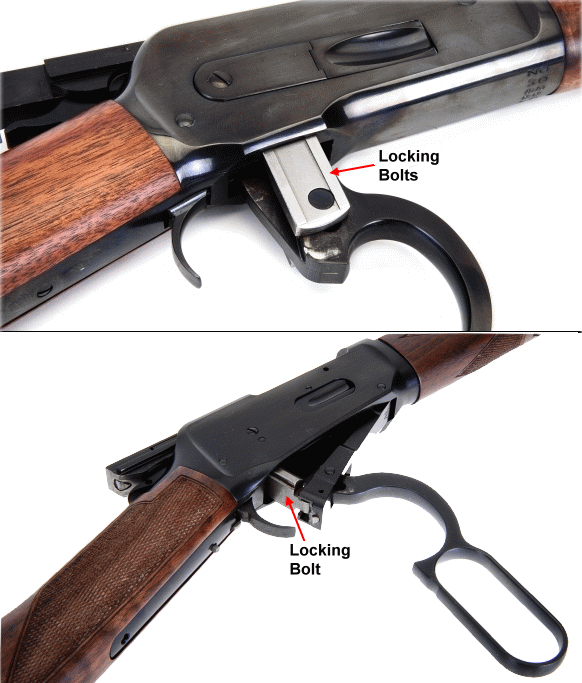
Above, Model 1892 top image, Model 1894 bottom. The Model 1892’s side locking bolts move perpendicular to the bore. The Model 1894’s rear locking bolt moves with the bottom of the receiver and locks with a 10° rearward cant relative to the bolt’s longitudinal axis, but parallel to the rear surface of the breech bolt. The Model 1894 differs from the Models 1886 and 1892 in that the bottom of the Model 94’s receiver is hinged and toggles the motion of the lever to allow a longer bolt stroke within a compact receiver length. Side rails on the breech bolt make for smooth bolt travel and locate and hold the bolt to bore centerline.
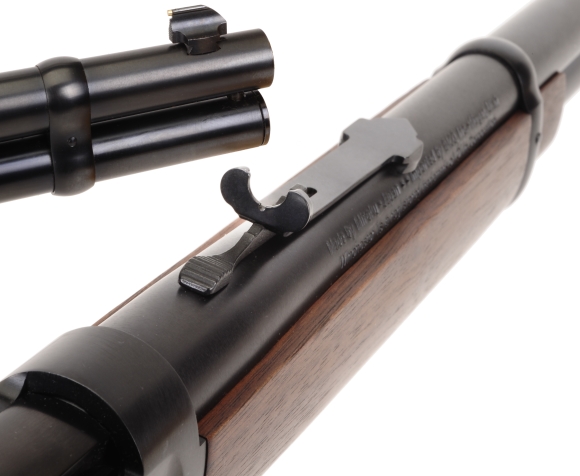
While simple , the front and rear sights are short and longer reach capable. The combination of the centering buckhorn form with precision notch and front bead make for fast target acquisition and precision shot placement. For folks who think they are too basic; practice until comfortable with this sight type. It is worth the effort, and never experience the loss of a system to dead batteries or a scopes fallen reticles.
The 30-30 Winchester cartridge
The 30-30 Winchester was America’s first sporting rifle centerfire smokeless cartridge, introduced in 1895 as a caliber option for the Winchester Model 1894. The 30-30 designation reflects .30 caliber and 30 grains of powder for the original load that produce 1,970 fps muzzle velocity with a 160 grain bullet. Lever, bolt and pump action firearms have been chambered for the cartridge, as well as rolling block and break action firearms. As the 7.62x51R, European designation, the cartridge was popular in single shot and drillings and combination firearms.
The 30-30 Winchester chambered Model 1894 is fast handling, compact, light in weight and high capacity. In the hands of competent hunters, it is capable of clean kills on deer size game at 200 yards and elk size game a bit closer. While Winchester limits their 30-30 Winchester ammunition to deer size game, companies like Federal and Hornady list 30-30 Winchester products as suitable for big, thin skinned, game up to 1,500 lbs.
Currently, there are forty two factory loads, sold under twelve ammunition brands for the 30-30 Winchester shooter. They are loaded in bullet weights from 125 grains to 190 grains, including subsonic, lead, jacketed lead and lead free projectiles. An example of factory ammo performance…
| 30-30 Winchester – Hornady 160 Grain FTX Factory Ammo | ||||||||
| Yards | 0 | 50 | 100 | 150 | 200 | 250 | 300 | |
| Velocity – fps | 2400 | 2274 | 2151 | 2033 | 1919 | 1808 | 1702 | |
| Energy – ft.-lbs. | 2046 | 1836 | 1644 | 1468 | 1308 | 1162 | 1029 | |
| Momentum – lbs-sec | 55 | 52 | 49 | 46 | 44 | 41 | 39 | |
| Path – in. | -1.50 | 1.56 | 2.94 | 2.43 | -0.17 | -5.14 | -12.77 | |
The “You can’t save money reloading the 30-30 Winchester” myth
A 30-30 Winchester cartridge offers a good deal of potential for the handloader; accuracy tuning to a specific firearm, combinations of components not available in factory ammunition including home cast bullets and substantial cost savings. When opponents of reloading want to dismiss the option of handloading, they often suggests there are no meaningful savings to be had. They will make their case by pointing to the lowest priced factory ammunition available and compare it to the most expensive reloading components that could be used by a handloader.
Quality, but basic name brand factory ammunition is currently priced between $18 and $21 per box of 20, or 90 cents to $1.10 per round. Premium product lines within those brands… Barnes, Federal, Hornady, Winchester are priced at $40 to $50 per box of twenty, or $2 to $2.50 per round. Specialty brands, like Buffalo Bore, price their ammunition at $92 per box of 20, or $4.60 per round.
New Winchester 30-30 WCF brass is priced at $19 per 50 pieces, or 38 cents per casing. Brass can be loaded at least five times, if not ten. So, conservatively, the cost of brass is 7.6 cents per cartridge reloaded. We’ll round that up to an even 8 cents.
The price of smokeless powder has dramatically increased to approx $30/lb. With a nominal 30-30 Winchester case charge of 35 grains, a 7000 grain container yields 200 rounds of handloads for 15 cents per round.
Primers, another commodity that has surged in price, are currently at 4 cents per round.
The range of bullets prices is wide as there is substantial variety and most are application specific. A Speer Hot-Cor 150 grain JSP costs approximately 24 cents per. A Meister Hard Cast 150 grain runs 12 cents per bullet. Lead free bullets… a Barnes Triple Shock FN costs 76 cents per, the Nosler E-Tip runs $1.10 per bullet and there are others that fall within that range.
Yes, costs vary by a couple of bucks for factory and reloaded ammo, but the advantage is clear. Plus, who doesn’t want to hunt with ammunition the carefully assembled with their own hands?
| Reload to Factory Ammo Comparison |
$ Brass | $ Powder | $ Primer | $ Bullet | $ Round | $ Box of 20 | $ Factory Box of 20 |
$ Savings Box of 20 |
| Basic Hunting Ammo Hard Cast Bullet |
0.08 | 0.15 | 0.04 | 0.12 | 0.39 | 7.80 | 18.00 – 21.00 | 10.20 – 13.20 |
| Premium Ammo Barnes JSP 190 grain (Same as Buffalo Bore) |
0.08 | 0.15 | 0.04 | 0.68 | 0.95 | 19.00 | 40.00 – 92.00 | 21.00 – 73.00 |
No +P+ 30-30 Winchester handloads please
Some folks see the 45-70 Government with a standard pressure of 28,000 psi, pushed by some independent ammunition loaders to pressures of 36,000 psi – 40,000 psi with astounding results and while pushing the limits of the receiving rifles. Why not do the same with the 30-30 Winchester cartridge? Numerous reasons.
The 30-30 Winchester’s standard pressure SAAMI ammo is already 42,000 psi, 46,000 psi for CIP ammo, and the 30-30 Winchester generates a comparatively high level of bolt thrust. There is no similar increments of opportunity to explore. Plus, the sharply tapered 30-30 Winchester brass in a lever action rifle tends to stretch excessively with even modest increases in pressure. The result is a lot of wear and tear on the rifle, short brass life, the potential for case head separation, and little to be gained.
What makes the 45-70 +P loads so interesting is not trajectory flattening velocity increases, but rather big kinetic energy gains as K.E. increases at approximately the square of the velocity. Bump a 400 grain bullet by 300 fps and 400 grains @ 1700 fps and 2568 ft.lbs of energy becomes 2000 fps and 3554 ft.lbs of energy. Hunting applications move from big game to big and dangerous game.
Even if a 150 grain 30-30 Winchester bullet could be safely pushed 300 fps, 2300 fps and 1762 ft.lbs would only become 2600 fps and 2252 ft.lbs of kinetic energy. Hunting potential would have gone… nowhere. The 30-30 Winchester is an easy shooting, inexpensive round of moderate power. Accept it for what it is and put it to work as intended.
Diversity
There are many bullets for the 30-30 Winchester handloader. Flat nose, round nose or soft point spire FTX, they are all safe in a tubular magazine. Notations below, as they appear above left to right.
The Barnes X, FN is a no lead content bullet, legal in states where someone convinced legislators that a moose might find a stray bullet in a million acres, eat it and drop dead, or that there are hunters who leave lead in harvested meat, cook both and then eat it and… drop dead. Probably next to a moose.
The problem with low density, all copper alloy bullets is that they are very long. They rob cases of powder capacity, they produce higher levels of bore friction and they do not stabilize well with standard rifling twist rates. That said, where used, they do penetrate well and expand properly even at 30-30 Winchester level velocity.
Remington Core-Lokt 150 grain bullets are killer, literally. Over many years of hunting with the 30-30 Winchester, under many circumstances, most all game was taken with this bullet. No, not specifically THIS bullet, but rather this type of bullet. Leaving a behind the shoulder 3″ exit wound in a big pig is not an easy task, but that has been the result. Inexpensive and effective hunting bullet.
The Sierra Pro Hunter is very similar to the Remington Core-Lokt in performance, but at twice the price. The Remington bullet has a slightly better BC at 0.195 versus 0.185 for the Sierra.
The Hornady FTX at a weight midpoint between the old 150 and 170 gain standard brought pointy bullets safely to the 30-30 Winchester. They are also a very long bullet with a shank that protrudes into a case about the same as a monolithic Barnes. The FTX is a high antimony content lead core bullet. Hornady also offers a solid copper Monoflex for the 30-30 Winchester at 140 grains. Is the point worth it?
In this first comparison, the velocity was set to 2300 fps to isolate bullet performance from velocity differences. Clearly, the Hornady FTX outperforms the Remington bullet… on paper… at the same velocity.
| Remington 150 grain Core-Lokt | |||||||
| Near-Zero – yds. | 20 | Mid Range – yds. | 102 | ||||
| Far-Zero – yds. | 177 | Max Ordinate – in. | +3.0 | ||||
| Point Blank – yds. | 188 | ||||||
| Best Zero : Range 0 – 300 yards | ||||||||||||
| Yards | 0 | 50 | 100 | 150 | 200 | 250 | 300 | |||||
| Velocity – fps | 2300 | 2095 | 1901 | 1719 | 1550 | 1400 | 1268 | |||||
| Energy – ft.-lbs. | 1762 | 1462 | 1204 | 984 | 801 | 653 | 536 | |||||
| Momentum – lbs-sec | 49 | 45 | 41 | 37 | 33 | 30 | 27 | |||||
| Path – in. | -1.50 | 1.73 | 2.98 | 1.82 | -2.30 | -10.04 | -22.23 | |||||
| Drift – in. | 0.00 | 0.00 | 0.00 | 0.00 | 0.00 | 0.00 | 0.00 | |||||
| Time Of Flight – sec. | 0.00 | 0.07 | 0.14 | 0.23 | 0.32 | 0.42 | 0.53 | |||||
| Hornady 160 grain FTX | |||||||
| Near-Zero – yds. | 20 | Mid Range – yds. | 108 | ||||
| Far-Zero – yds. | 190 | Max Ordinate – in. | +3.0 | ||||
| Point Blank – yds. | 202 | ||||||
| Best Zero : Range 0 – 300 yards | ||||||||||||
| Yards | 0 | 50 | 100 | 150 | 200 | 250 | 300 | |||||
| Velocity – fps | 2300 | 2177 | 2058 | 1943 | 1831 | 1724 | 1622 | |||||
| Energy – ft.-lbs. | 1879 | 1683 | 1504 | 1340 | 1191 | 1056 | 934 | |||||
| Momentum – lbs-sec | 53 | 50 | 47 | 44 | 42 | 39 | 37 | |||||
| Path – in. | -1.50 | 1.65 | 2.97 | 2.23 | -0.81 | -6.45 | -15.01 | |||||
| Drift – in. | 0.00 | 0.00 | 0.00 | 0.00 | 0.00 | 0.00 | 0.00 | |||||
| Time Of Flight – sec. | 0.00 | 0.07 | 0.14 | 0.21 | 0.29 | 0.38 | 0.47 | |||||
However, I was unable to get accurate, acceptable pressure results at the same velocity levels from both bullets. The Remington lived happily at 2511 fps, while the Hornady did well at 2322 fps, which plays out as (drum roll) :
| Remington Core-Lokt | |||||||
| Near-Zero – yds. | 22 | Mid Range – yds. | 111 | ||||
| Far-Zero – yds. | 191 | Max Ordinate – in. | +3.0 | ||||
| Point Blank – yds. | 203 | ||||||
| Best Zero : Range 0 – 300 yards | ||||||||||||
| Yards | 0 | 50 | 100 | 150 | 200 | 250 | 300 | |||||
| Velocity – fps | 2511 | 2295 | 2090 | 1897 | 1714 | 1546 | 1396 | |||||
| Energy – ft.-lbs. | 2100 | 1753 | 1455 | 1198 | 979 | 796 | 649 | |||||
| Momentum – lbs-sec | 54 | 49 | 45 | 41 | 37 | 33 | 30 | |||||
| Path – in. | -1.50 | 1.54 | 2.93 | 2.32 | -0.71 | -6.71 | -16.35 | |||||
| Drift – in. | 0.00 | 0.00 | 0.00 | 0.00 | 0.00 | 0.00 | 0.00 | |||||
| Time Of Flight – sec. | 0.00 | 0.06 | 0.13 | 0.21 | 0.29 | 0.38 | 0.48 | |||||
| Hornady 160 gain FTX | |||||||
| Near-Zero – yds. | 21 | Mid Range – yds. | 109 | ||||
| Far-Zero – yds. | 192 | Max Ordinate – in. | +3.0 | ||||
| Point Blank – yds. | 204 | ||||||
| Best Zero : Range 0 – 300 yards | ||||||||||||
| Yards | 0 | 50 | 100 | 150 | 200 | 250 | 300 | |||||
| Velocity – fps | 2322 | 2198 | 2078 | 1962 | 1851 | 1743 | 1639 | |||||
| Energy – ft.-lbs. | 1915 | 1716 | 1534 | 1368 | 1217 | 1079 | 954 | |||||
| Momentum – lbs-sec | 53 | 50 | 48 | 45 | 42 | 40 | 37 | |||||
| Path – in. | -1.50 | 1.63 | 2.96 | 2.28 | -0.66 | -6.14 | -14.49 | |||||
| Drift – in. | 0.00 | 0.00 | 0.00 | 0.00 | 0.00 | 0.00 | 0.00 | |||||
| Time Of Flight – sec. | 0.00 | 0.07 | 0.14 | 0.21 | 0.29 | 0.37 | 0.46 | |||||
The Hornady FTX still outperformed the Remington 150 grain Core-Lokt… or did it? The Remington bullet cost 24 cents per bullet, the Hornady cost is 44 cents… $4 per box of 20 more for the Hornady. Not enough to offset the gain. Performance on game? Can’t tell, as I do not have more than inconsequential experience with the Hornady bullet. I do have 5,000 Remington Core-Lokt bullets on the shelf. The Remington wins hands down!!…! Of greater importance in the selection process, typical shots at Maine deer are taken inside 100 yards, where the Remington ballistically outperforms the Hornady, even theoretically.
The 170 grain Nosler round nose, soft point is a good one. Ballistic coefficient approximately halfway between the Remington Core-Lokt and Hornady FTX, tough H jacket bullet that expands fully at 30-30 WCF velocity, is magazine safe and feeds well through the Winchester.
The 170 grain cast TrueShot is low cost, deep penetrating on game and actually quite accurate. It also makes a good light load for target practice and work on smaller game where it doesn’t expand or fragment.
Handloads and handload data
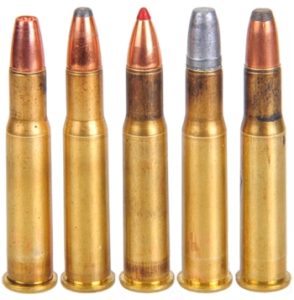
Once fired Remington brand cases were cleaned, full length resized and trimmed. Bullets were secured with a Lee factory crimp die. Some cases were near full, none were compressed charges. Magnum Large Rifle primers were not used with Winchester 748 powder.
Warning: Bullet selections are specific, and loads are not valid with substitutions of different bullets of the same weight. Variations in bullet length will alter net case capacity, pressure and velocity. Primer selection is specific and primer types are not interchangeable. These are maximum loads in my firearms and may be excessive in others. All loads should be reduced by 5% as a starting point for development where cartridges have greater than 40 grains in capacity and 10% for cartridges with less than 40 grain capacity following safe handloading practices as represented in established mainstream reloading manuals. Presentation of these loads does not constitute a solicitation for their use, nor a recommendation.

| 30-30 Winchester – MAP 42KPS |
|
| Firearm | Winchester Model 94 |
| Barrel Length | 20.0″ |
| Max Case Length | 2.0395″ +0.000″/-0.020″ |
| Min – Max COL | 2.450″ – 2.550″ |
| Primer | CCI 200 – Large Rifle |
| Bullet Diameter | 0.3090″ +0.000″/-0.0030″ |
| Reloading Dies | RCBS FL |
| Bullet Type | Bullet Weight Grains |
Net H2O Grains Capacity |
COL” | Powder Type | Powder Charge Grains |
Muzzle Velocity fps |
Muzzle Energy ft/lbs |
| Barnes XFN | 150 | 33.2 | 2.470 | Re 15 | 34c | 2312 | 1781 |
| Barnes XFN | 150 | 33.2 | 2.470 | Hodgdon CFE 223 | 35.0 | 2343 | 1829 |
| Barnes XFN | 150 | 33.2 | 2.470 | IMR 3031 | 31.0 | 2274 | 1723 |
| Remington RNSP | 150 | 37.1 | 2.540 | Hodgdon H-335 | 34.0 | 2427 | 1962 |
| Remington RNSP | 150 | 37.1 | 2.540 | Hodgdon CFE223 | 38.0 | 2511 | 2101 |
| Remington RNSP | 150 | 37.1 | 2.540 | Win 748 | 36.0 | 2466 | 2026 |
| Sierra FN | 150 | 37.4 | 2.540 | Alliant Varmint | 33.5 | 2207 | 1623 |
| Sierra FN | 150 | 37.4 | 2.540 | Hodgdon CFE223 | 37.5 | 2345 | 1832 |
| Sierra FN | 150 | 37.4 | 2.540 | Hodgdon Varget | 35.0 | 2424 | 1958 |
| Hornady FTX | 160 | 33.2 | 2.540 | Alliant Re 15 | 32.0 | 2222 | 1755 |
| Hornady FTX | 160 | 33.2 | 2.540 | Hodgdon CFE223 | 34.5 | 2322 | 1916 |
| Hornady FTX | 160 | 33.2 | 2.540 | Hodgdon Varget | 32.0 | 2311 | 1898 |
| Nosler Partition RN | 170 | 35.2 | 2.540 | Alliant Varmint | 31.0 | 2087 | 1645 |
| Nosler Partition RN | 170 | 35.2 | 2.540 | Hodgdon Varget |
33.0 | 2305 | 2006 |
| Nosler Partition RN | 170 | 35.2 | 2.540 | IMR 3031 | 31.0 | 2244 | 1901 |
| TrueShot Cast FN | 170 | 35.7 | 2.535 | Hodgdon H-335 | 32.0 | 2273 | 1951 |
| TrueShot Cast FN | 170 | 35.7 | 2.535 | Win 760 | 37.0 | 2290 | 1980 |
| TrueShot Cast FN | 170 | 35.7 | 2.535 | Norma 203B | 34.0 | 2245 | 1903 |
| TrueShot Cast FN | 170 |
35.7 |
2.535 |
IMR Trail Boss |
8.5 |
1071 |
433 |
Handload observations?
The goal in each case was accuracy without pushing pressure to an excess. Subsequently, velocity varies significantly within bullet weight groups. Please keep in mind that factory ratings are based on 24″ test barrels, not 20″ carbine barrels.
Some newish powder types were worked into the project. Usually, particularly the case with Alliant Powder, whatever is a new powder listing seems to consistently reflect major velocity gains over earlier product types. Unfortunately, the listings and the chronograph are often at odds. In some cases, like Hodgdon CFE223 the suggested gain is easily realized.
Accuracy with loads posted were very good. I think there is a reason Winchester Lever guns lost some of their 100 yard group size performance when they stopped drilling and tapping rifles for scope mounts; writer’s eyesight and open sight mastery… or lack of the same. Which is why I am not posting group sizes. All of the posted loads will put 5 shots on a regulation size playing card at 50 yards. Much smaller than the vitals of a deer and most Maine snow shoe hares.
None of the handloads were difficult to feed, all cycled, all easily extracted and ejected, loaded or as empties.
Winchester shooting observations
What I really appreciate is that, unlike most recent, pre Ruger purchase Marlins, the Winchester remains tight, trim and compact. No bulbous, capped forearms, no hefty pistol grip, no garish patterned checkering that Marlin had evolved into. This shows on the scale, it shows when acquiring a target and it shows when carrying it up and down Maine’s granite filled hills and mountains.

Winchester’s nomenclature for the butt end of the Winchester Model 1894 Carbine is “carbine, metal strap”. That it certainly is. Did not notice it while shooting, didn’t hang up on bulky winter clothing. Recoil is so mild that a recoil pad would be superfluous and a straight cut steel butt plate would look… goofy. I figure there are eight Model 94 types to select from, so if preferences are different from this basic carbine, there are others.
The lever… OK, I hate big loop levers. They are most suitable for TV shows that are no longer with us. Even in my comfy shooting sweats, a big loop lever makes me feel like a… dandy. I’m old, so I know what that means. You may have to look up the definition. That said, it is a little tight getting enough fingers in the lever and compressing the trigger stop enough to release the trigger. Of course, the lever has been that way for 127 years and my problem arose a few days ago, so perhaps not a big deal and I prefer the compact carry.
The action is slick, fast and the finish on metal bits and wood are very good. Certainly not a handling mark magnet and a quick clean up after shooting. If there is a need for a mechanical safety, the tang is a good place to put it, aesthetically and ease of use. I really don’t care for those Frankenstein receiver mounted cross bolt safeties. The rebounding hammer offers safety in handling and it has been too long since I have owned a gun with a half cock position to even notice the difference. The Winchester Model 94 is as relevant today in woodland hunting as it was in 1894. Honestly, not much has come along that makes for a better deer rifle.


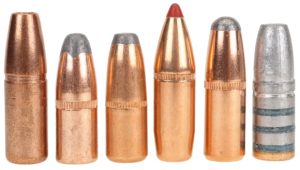
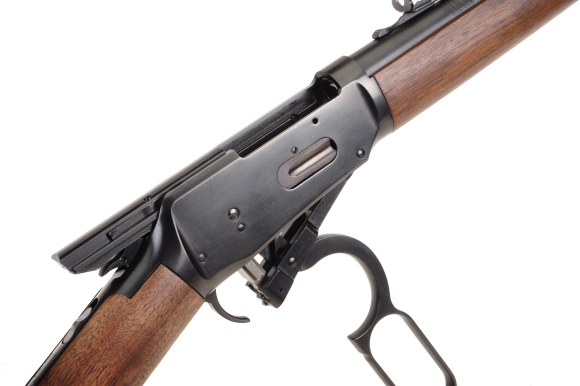
Email Notification